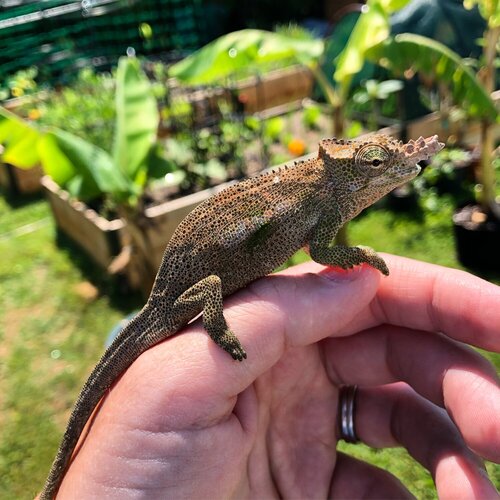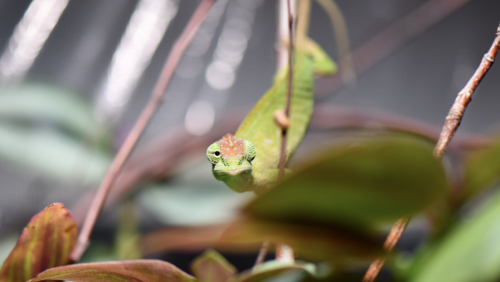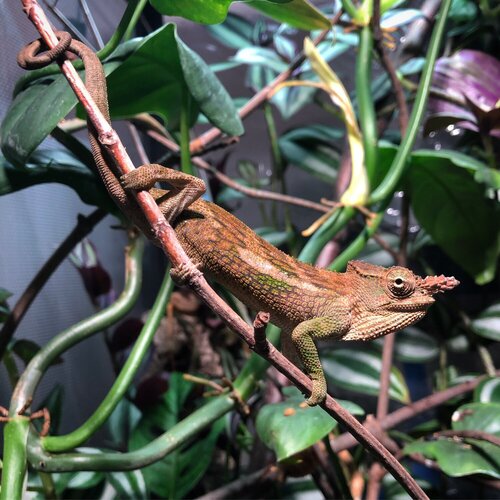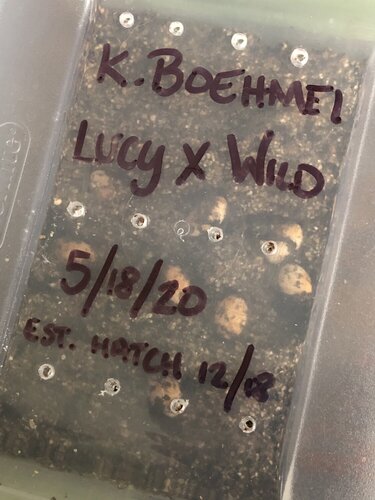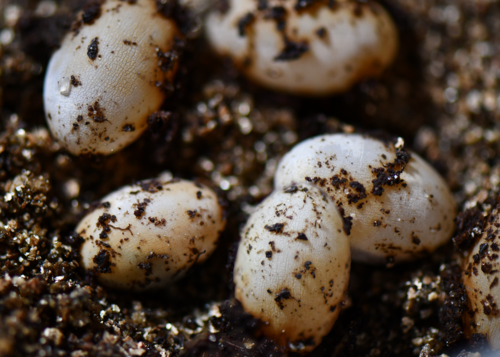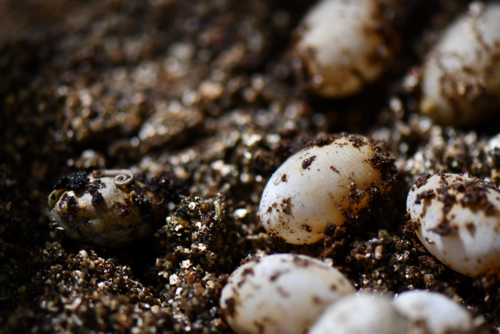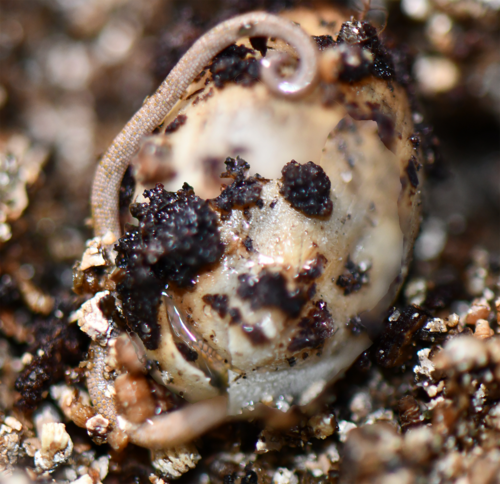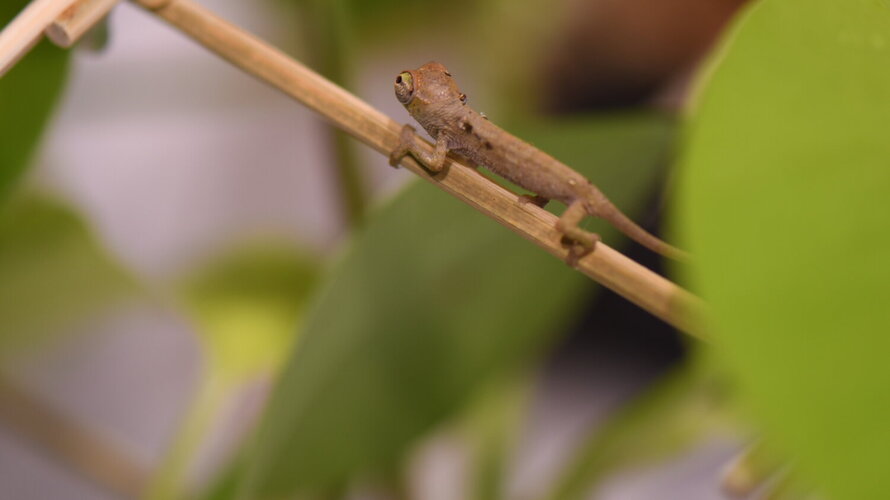Navigation
Install the app
How to install the app on iOS
Follow along with the video below to see how to install our site as a web app on your home screen.
Note: This feature may not be available in some browsers.
More options
You are using an out of date browser. It may not display this or other websites correctly.
You should upgrade or use an alternative browser.
You should upgrade or use an alternative browser.
-
- Captive Experience
- From 3 to 5 years
- Experience began in January, 2020
- Total Specimens
- 6
- Oldest Male
- 3 years 2 months
- Oldest Female
- 3 years 2 months
- WC Specimens
- 2
- WC Gravid Females
- 1
Captive Experience
2/2024 update: my “babies” are now 3 years old and recently laid their first clutch of infertile eggs. Everyone is doing well and I have a pair of (pressumably wild caught) k boehmei on the way to hopefully one day pair with my females.

2023 update: both my WC adults passed away, ages unknown. My WC female laid a clutch of 9 eggs, all of which hatched with 8 f and 1 m. 100% survival rate. I kept 2 females, who are now over 2 years old. My WC also must have retained sperm and laid more eggs months later. I found two tiny babies in her cage. Neither thrived. My 2 holdback females are doing wonderfully in a glass enclosure with screen top. Misting 1x per day in the evening.
I am keeping a WC male and female of this species, each in its own 15x15x30
enclosure. Both enclosures are “bioactive” and densely planted with tradescantia, horsehead philodendron, monstera adansonii, and begonia thelmae. The philodendron in particular provides a great vining, climbing, drinking, and eating platform.
I keep them in my basement in the Mid Atlantic area. My basement temps
average around 70 degrees in summer and 60ish in winter. I do not supply a basking light, as the lighting from a dual t5 fixture keeps “basking” temps in the mid 70s. Ambient temps in the remainder of the enclosure are low 70s. Overnight temps are low to mid 60s in summer, 60 or lower in winter. Humidity in my basement is naturally around 40-50%. With daily misting (morning and evening), humidity ranges between 50-90% , with 50% being the lows in the daylight hours following misting. An overnight fogger is typically used, as well, which not only helps with nighttime temp drops, but raises humidity to near 100%.
I supplement with calcium every feeding on appx half of the feeders, and alternate d3 and mv every 3 -4 weeks on a few feeders. They are fed a variety of insects - newly hatched mantids, extra small/small silkworms, small bsfl, black soldier flies (bbf might be too large, havent tried), micro superworms, small meadow katydids, xsmall dubia, 2-3 week crickets, phasmids, and xsmall hornworms. Fruit flies are too small to be worthwhile for adults, but they do seem to enjoy the occasional buffalo beetle. Have not tried bean beetles, yet. Feeders are typically .5” or smaller, depending on girth. Phasmids are usually rather slim and soft, so up to 1” is still manageable for thin species. Newly hatched mantids are a great feeder, and I hatch them directly in the enclosures. The mantids are usually devoured within 2-3 days. Number of feeders offered varies from 4-8 depending on feeder type and their appetite. They are fed 3x a week. Interestingly, they seem to use their mits on occasion to grasp the insect they are eating, while eating it.
They stress and show signs of overheating (gaping, turning white-ish) at 80 degrees of higher.
Typically, the male is a rusty brown color with a bright green spot on its side, and a green tint on his front legs. When frightened, he will turn very light colored (almost white), with a faint black contrast between his scales, and a dark green spot in the center of his sides.
The female is typically bright green with red on the top of her head. On occasion she will display white spots along her body, and occasionally will have small lavender colored spots along the edge of her red head. She’s quite small, so it is difficult to spot the purple without a camera. I have not noticed a trend in her colors when gravid, frightened, angry, etc.




-
- Breeding Experience
- Less than 1 year
- Breeding experience began in January, 2020
- Total Clutches
- 1
Breeding Notes
My female Lucy was gravid when I acquired her. She was quite small, and I was unsure if she was gravid. Her coloration and activity level were not much different then her regular activity. She laid 9 fertile eggs, which are currently incubating (as of 9/2020). Eggs were laid on 5/18/20 and are expected to hatch around 12/18/20.

Update: The first egg cracked open on 12/6 - just shy of the 7 month mark. I did not notice any "sweating" or warning signs in advance. The first baby's tail was exposed first, no its head. Still waiting on it to emerge, which it is hopefully able to do successfully on its own. The other eggs have not yet hatched as of 12/7.
Update 12/8: Its been 2 days since the first egg cracked up, and the chameleon is still alive, but still "tail out." Half of the eggs have shrunk in size over night. They lost half their size in about 18 hours, telling me that babies will be on the way soon.
Here you'll notice the eggs at the bottom left, which have shrunk in size and are about half the size of the others. I did not notice the "sweating" on the eggs, but that is what is happening here. The change in size happened overnight.

Here you can see the size of the first egg that cracked open, compared to the others, with the tail still hanging out.

The first egg that cracked open, tail first.

Update 1/28/21
All 9 eggs hatched and the babies are just over 1 month old. The babies were placed in a large storage tote with a screened front / lid, some plants, and a structure made out of bamboo skewers. After 3-4 weeks, I began separating the babies into smaller, individual bins with a screened front and roof. I opted to use a coco earth substrate instead of paper towels, along with live plants and real (very fine) branches. I let the branches reach only half way to the top of the container, for fear of getting too close to the UVB fixtures, as well as to avoid injury due to them climbing the screen w/o a fully screened side to easily climb back down. The babies seem a bit insecure with the shorter branches so I will be adding more plants and branches, allowing them to screen climb, but giving them plenty of routes to get down.
The babies are eating Turkish Glider FFs, which are smaller and reproduce much faster than hydei. I am supplementing every other feeding with calcium & bee pollen, and will do some research on introducing a MV and D3, but will be doing so extremely cautiously.
At 1.5 months, they are all going through their first shed (at least, the first I've noticed), and have grown a bit, but are still incredibly small. Initially, most babies look like small females, with bright green bodies and red heads, however, I'm starting to see some variations in patterns when they are in contact with each other... but it is still too soon to gauge the sexes.
Update 5/27/21
The babies are almost 6 months old and have begun going off to new homes. All did well and are seemingly very healthy. 8 females and 1 male, poor guy! All were raised in individual setups after the first month, and very much preferred it. One pair (that I dubbed "the twins") were kept together a bit longer due to not having enough space for 9 enclosures. They were both female and got along w/o fighting, but they did annoy each other by climbing on each other. They were eventually split up but I still refer to them as the twins.At this age, I'm still feeding most of the same items. silkworms are a staple, along with baby mantids and phasmids. Trying to introduce dubia, but it is so difficult due to their lack of activity. Had better success with dubia tong feeding than cup feeding. Fruit flies are still offered (Hydei) as a quick and easy feeder, but also a very active feeder and different variety. I would keep them as a staple, even for adults. Plus, they can be used to gutload the mantids.
Attachments



